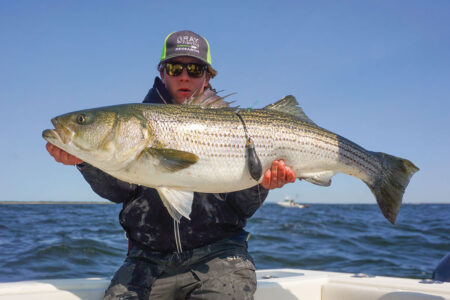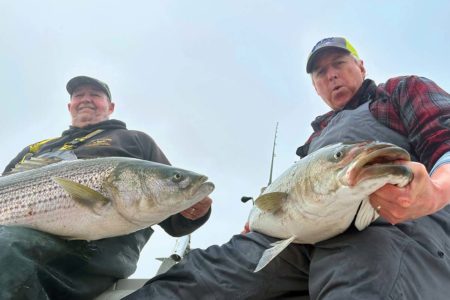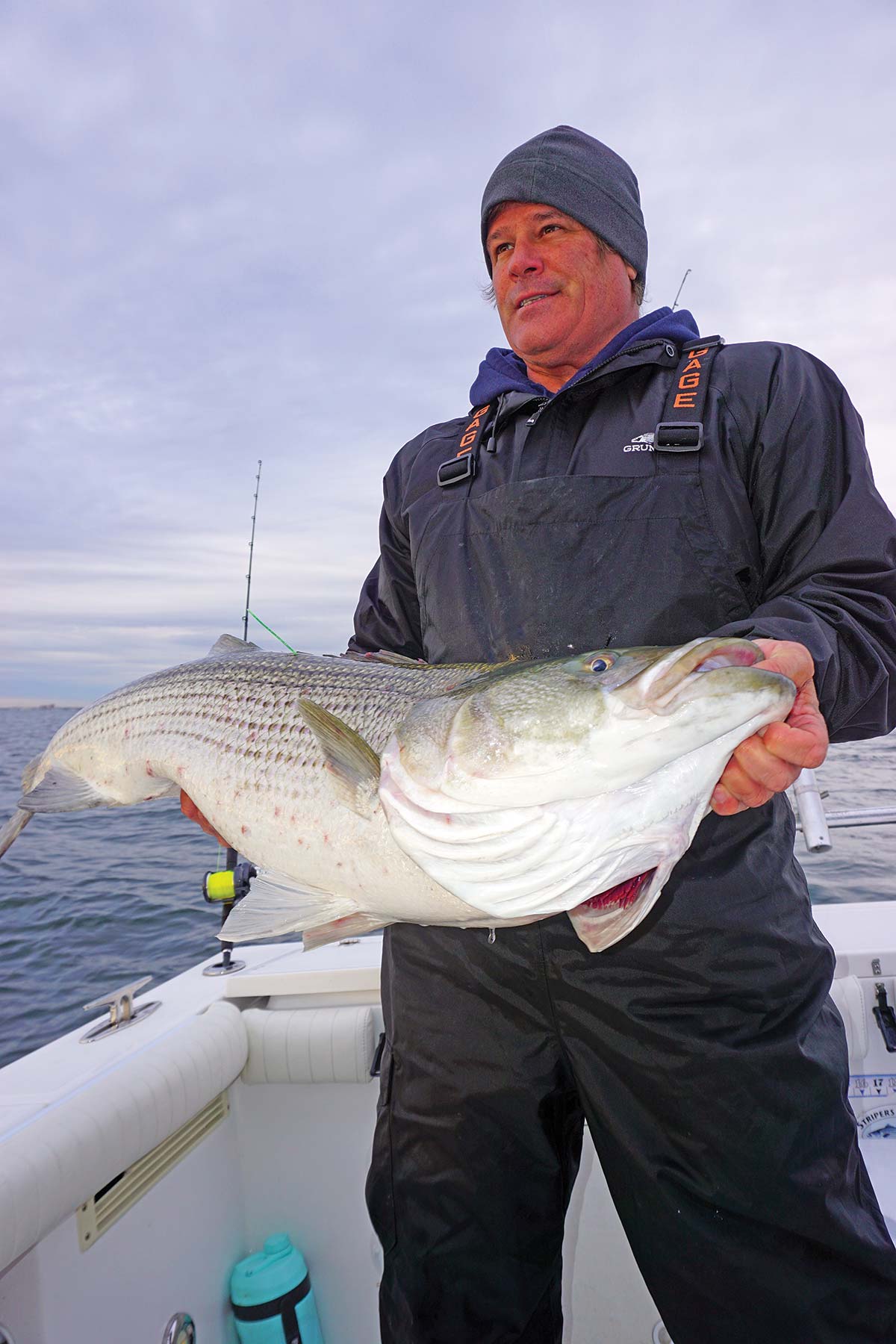
Tracking last season’s final study subjects, Uncle Fred & RFA!
From May 24 through December 13 of 2021, our team of dedicated Northeast Striped Bass Study taggers through the Gray FishTag Research partnership with The Fisherman Magazine deployed a total of seven MiniPAT pop-up archival transmitting tags (PAT tag, also known as a PSAT) in jumbo striped bass along the Atlantic Coast, ranging in size from 42 to 48 inches in length.
According to Wildlife Computers which produces the device, PAT tags are designed to track the large-scale movements and behavior of fish and other animals which do not spend enough time at the surface to allow the use of real-time Argos satellite tags. Depth, temperature, and light-level data, among others, are collected and summarized for transmission, and archived in onboard memory. Then on a preset date set by the researchers, the tag releases from its host fish, surfaces, and uploads a summary of the archived data to Argos satellites.
Throughout the second half of last year at The Fisherman, we detailed the tabulated results of five of those seven striped bass complete with tracking charts taken from data collected inside each MiniPAT device. Once coming undone from the fish via pre-programmed electronic charge – or as we’ve found in several instances in 2021, on its own – the MiniPAT will float to the surface and begin feeding the collected information to an Argos satellite for the duration of battery life which is typically around two weeks.
Best case scenario of course is when we’re able to actually find one of these needles in the proverbial haystack, as researchers can download the archive dataset to retrieve all of the valuable data contained inside.
In our reporting on tagging data from 2021, there were two final stripers tagged in the late fall that we’ve yet to present to readers, one being Uncle Fred that was caught, tagged and released aboard Chuck Many’s Tyman on November 2 off of Sandy Hook, and another fish named RFA that was tagged on December 13 off of Cape Charles, VA.
As we prepare for another year of satellite tracking of coastal striped bass this month for the 2022 Northeast Striped Bass Study, I invite you sit back and enjoy the highs and lows of 21st century technological tracking efforts with America’s fish, the Atlantic striped bass.
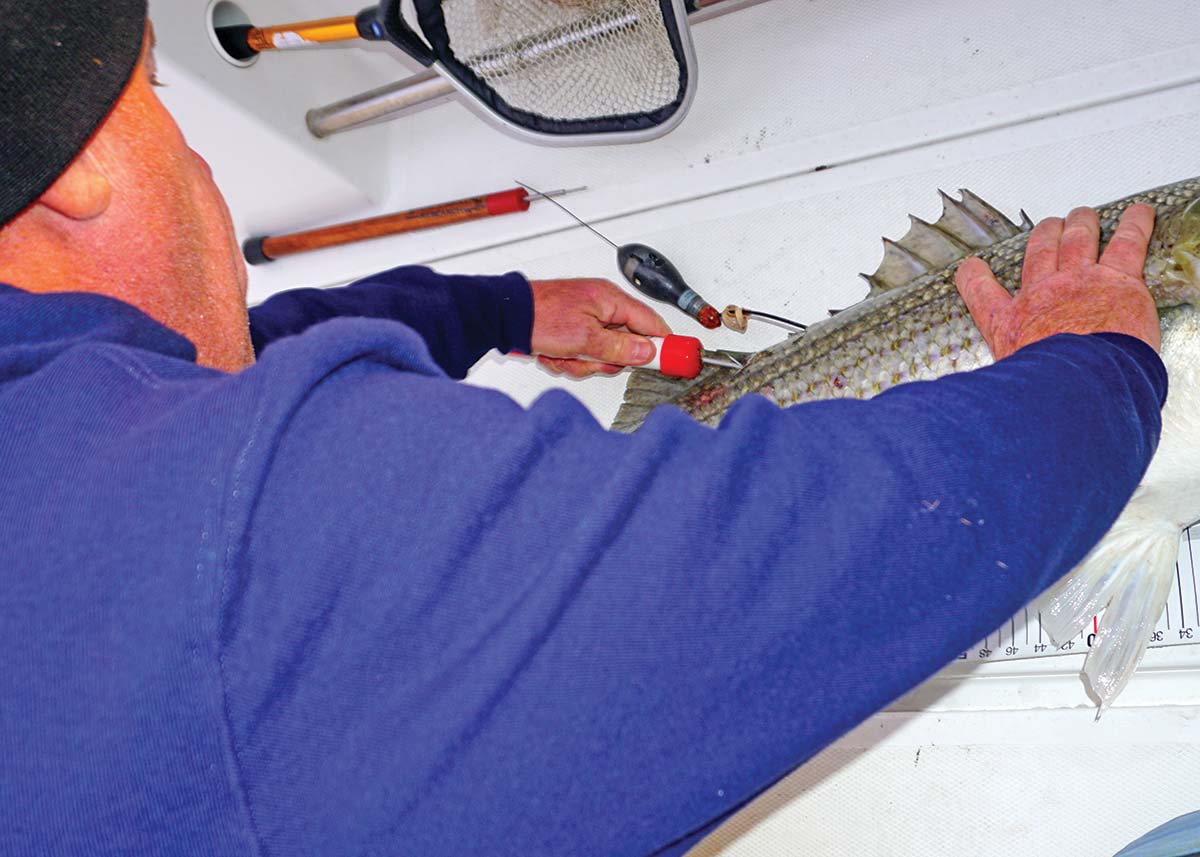
Uncle Fred
On November 2, 2021, my buddy Tom Lynch and I drove to Gateway Marina along Raritan Bay to meet up with fellow Northeast Striped Bass Study sponsor David Glassberg for a trip aboard Many’s Tyman in an effort to deploy our sixth MiniPAT device of the 2021 season. As highlighted in the December, 2021 edition of The Fisherman (“Striper Tag Update: Hail Mary & Uncle Fred”), about a half -hour into our light troll using live eels, Lynch grabbed hold of one of the bent rods and capably managed a 48-inch striped bass to the net. That fish was quickly and safely affixed with MiniPAT device along with a secondary GFR green streamer tag, swimming off healthy and strong.
That fish named Uncle Fred in honor of the late Fred Golofaro, longtime senior editor at The Fisherman Magazine, enjoyed a rather remarkable journey over the three months that the MiniPAT device stayed attached. According to the data contained within the MiniPAT (recovered along the shoreline at Tangier Island in the Chesapeake Bay), soon after being released on November 2 that fish spent another week or so in the NY Bight, from Deb’s Inlet on Long Island to the Jersey Shore, before taking a S/SE track in what appears to be the three-mile-line highway.
Checking The Fisherman’s fishing reports along the Central Jersey coast in mid to late November of 2021, we had a few epic surf blitzes along the Ocean County stretch through Thanksgiving, and by late in the month a fast-moving school of stripers raced down the beaches of Long Beach Island, which somewhat correlates with Uncle Fred’s travels. “I know you’re in Brigantine, Atlantic City, Ventnor, Sea Isle, Wildwood, are these fish on the way to Cape May,” is how I posed it in my weekly video forecast on December 2, 2021, while adding “but if they do get to your town it could be a quick-hitter.” Uncle Fred seems to corroborate that as well.
Within a few short days of being off of Atlantic City in November, that MinPAT seems to show this big fish as moving at a pretty solid clip before another cluster of activity shows Uncle Fred offshore beyond the three-mile-line off Delaware. By the end of November, Uncle Fred has already reached the Chesapeake Bay where it spends most of December in and around the Cape Charles, VA area. That’s where and we find Chuck Many’s Tyman again, with yet another MiniPAT device, seemingly intercepting those big bass he’d just left biting off the northern New Jersey Coast.
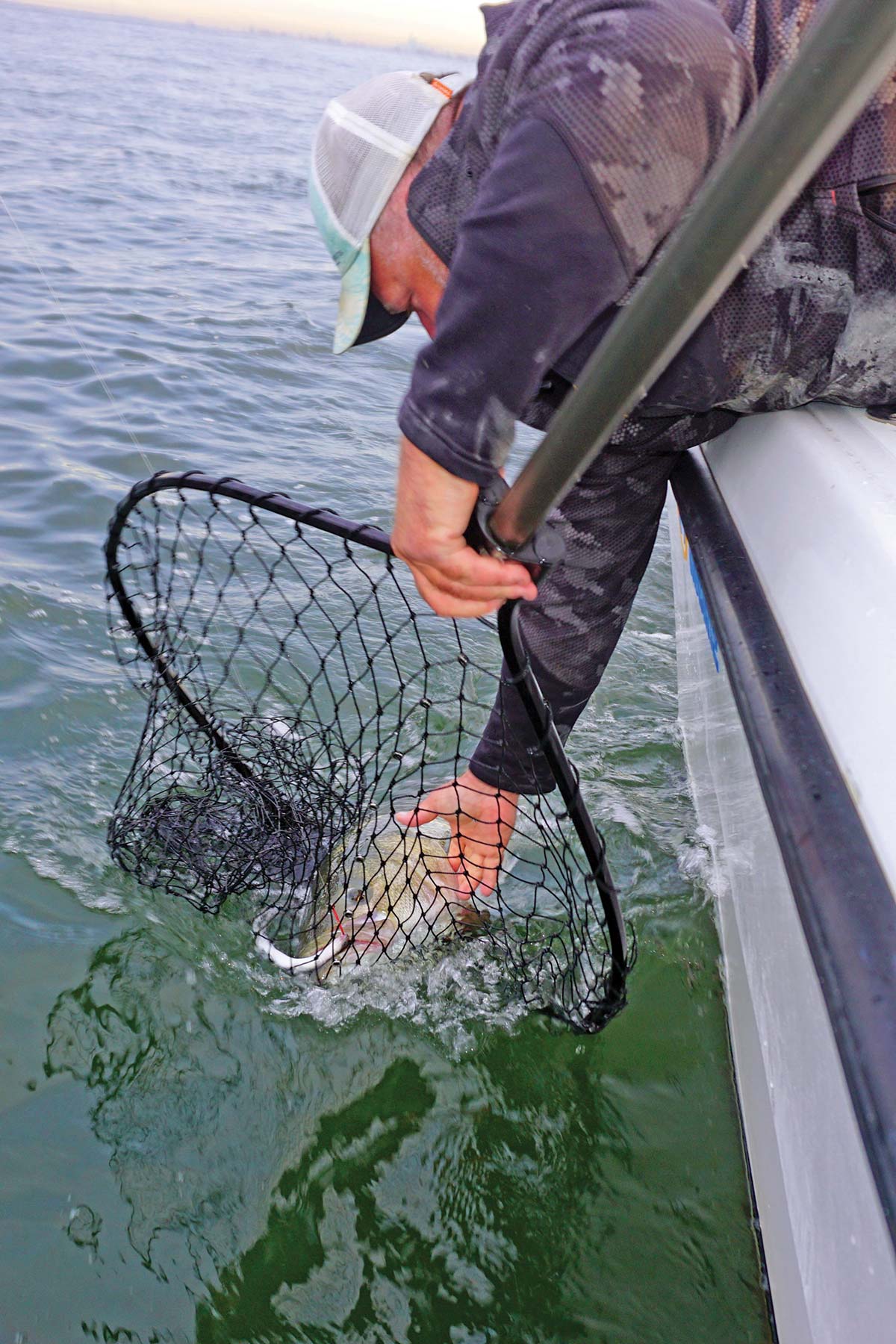
Offshore Migration?
In 2021, we began naming some of our sat-tagged stripers after financial supporters, something we will continue in 2022 when the tagging efforts kick off again this month. A couple of notable tagging specimens however boast special names – Uncle Fred being one, and the other a Hail Mary fish on June 17, 2021. From May 24 to June 30 of last year, we tagged three striped bass along the Jersey Shore (Navionics, AFW, Hail Mary) and two more (Seaguar, PENN) off Montauk, NY. You can learn more about the results from these tagging missions online at www.thefisherman.com/category/striped-bass-study.
Some of the rather shocking data contained inside these high-tech MiniPAT devices may best be described by the information collected from Hail Mary which was caught, tagged and released at Romer Shoal on the Raritan Bay. Nearly 100 days after tag deployment, the MiniPAT popped free from that 44-inch striper and was found at Westhampton Beach on Long Island.
Researchers from Wildlife Computers in Redmond, WA alongside of the Gray FishTag Research team in Pompano Beach, FL analyzed the information inside that device, and determined that Hail Mary tracked E/SE in parallel to the Hudson Canyon to Ambrose Channel Traffic Lane not long after the deployment, and showed a noted cluster of tracks in what appears to be the vicinity of the Bacardi and Texas Tower. She appears to have run parallel to Long Island’s south shore well outside of the three-mile-line before setting up for July and August from Nantucket Shoals to an area just inside Georges Bank off of Cape Cod, MA.
One of the region’s top jumbo striper fishermen, Chuck Many has fished a variety of lures and baits over the years, but his “trophy” tactic for catch and release giants is deploying live eels on circle hooks beneath planer boards allowing him to set out up to 12 outfits on a slow troll, half that on the drift. Each high-vis planer might have a different depth of deployment for the eel (four or five pulls from the spool versus eight or nine).
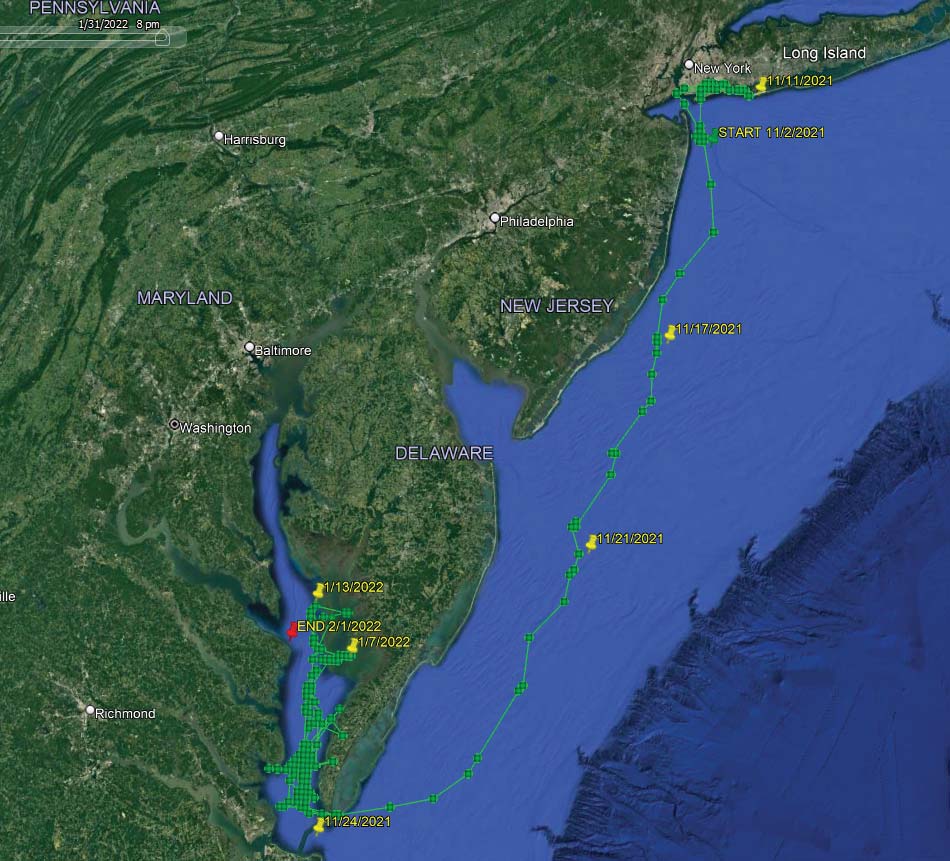 |
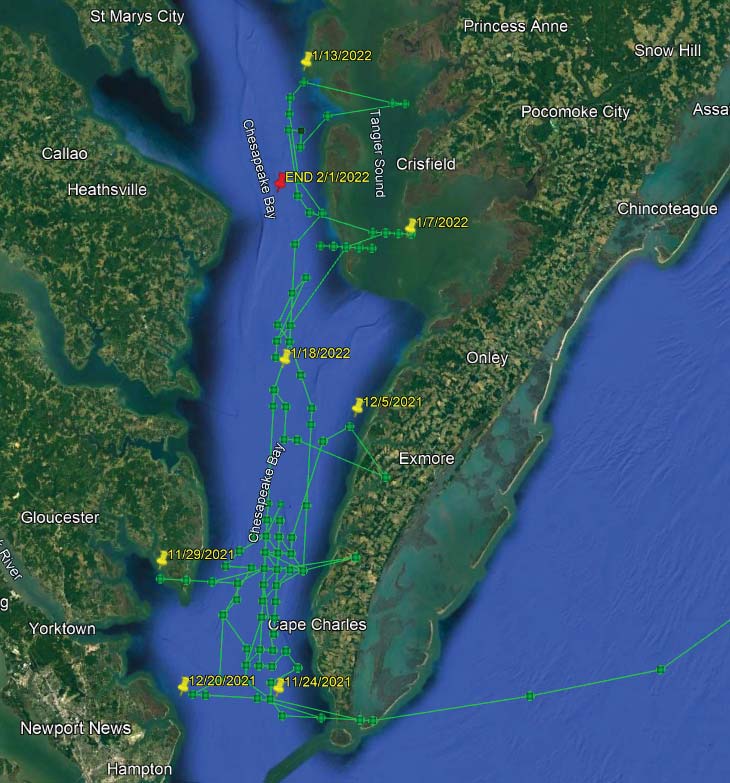 |
| The striper named Uncle Fred travels south on her fall migration, sticking primarily along the three-mile highway while periodically meandering back and forth across line, before finally settling into the Chesapeake Bay region during the first quarter of 2022. Ideally, that big old fat fecund female fish ended up dropping a load of eggs somewhere in the Chesapeake complex sometime during the month of April. | |
For years Many kept his trophy fishing method a pretty well-guarded secret, primarily to protect the spawning class stripers known to fall for this technique. Once the slot fish requirement was implemented requiring all “oversized” fish to be released, he’s felt a little more comfortable sharing his tactics publicly. But even more so he’s been quite public in his ongoing support for the Northeast Striped Bass Study.
“People always ask me, why do you do all this tagging of striped bass? My response, ‘because we don’t know much about them and what they really do’,” Many told me. Case in point; according to Chuck, what we often hear from anglers is what we’ve always been told:
- That 80% of the stock come from the Chesapeake with the rest coming from the Pamlico Sound stock, Hudson & Delaware Rivers.
- How the schoolies live in estuaries near where they were born and don’t migrate until they are larger
- And migrating striped bass are an inshore species that travel along the east coast and summer in New England , wintering off Virginia and North Carolina.
“Sure, those may have been assumed facts in the past, but my personal experiences fishing for striped bass for close to 50 years don’t support them,” Many said. “In the 90s, I used to bass fish every winter out of Wanchese along the Outer Banks of North Carolina, catch those fish all winter. Each year however that migration moved north, to the point that I moved the Tyman up to Rudee Inlet in Virginia, and then ultimately to Cape Charles, VA where I’ve been winter striper fishing for the past several years,” he added.
RFA In VA
Many said it’s pretty rare to encounter striped bass wintering off Virginia anymore, as most fish it would seem stay north, possibly staying off Maryland, Delaware and New Jersey. “And when it comes to the spawning stock, I have seen the number of spawning fish to the south in the Chesapeake dwindle, while the number of fish spawning to the north has seemingly exploded,” he said, adding “Why is that? Are they spawning in more northern rivers besides the Hudson?”
In an effort to learn more and perhaps seek a few of those answers, we brought back a MiniPAT device from a Gray FishTag Advisory meeting in Florida in December; just two days later on December 14 it was deployed on our first Chesapeake Bay striper for the Northeast Striped Bass Study, a 47-incher named RFA. While we had hoped that tag would stay attached until the spring spawn, it prematurely released on January 6, 2022 after just 25 days. The tracking map however still reveals some interesting data, as it shows the fish actively in the Chesapeake Bay but also leaving and returning for short periods of time.
It’s really impossible to ascertain where RFA was before she was tagged aboard the Tyman off Cape Charles, VA in late December, but when you look at the timing and locations of Uncle Fred’s route down the coast and into the Chesapeake, one can make reasonable assumptions, albeit worth debating.
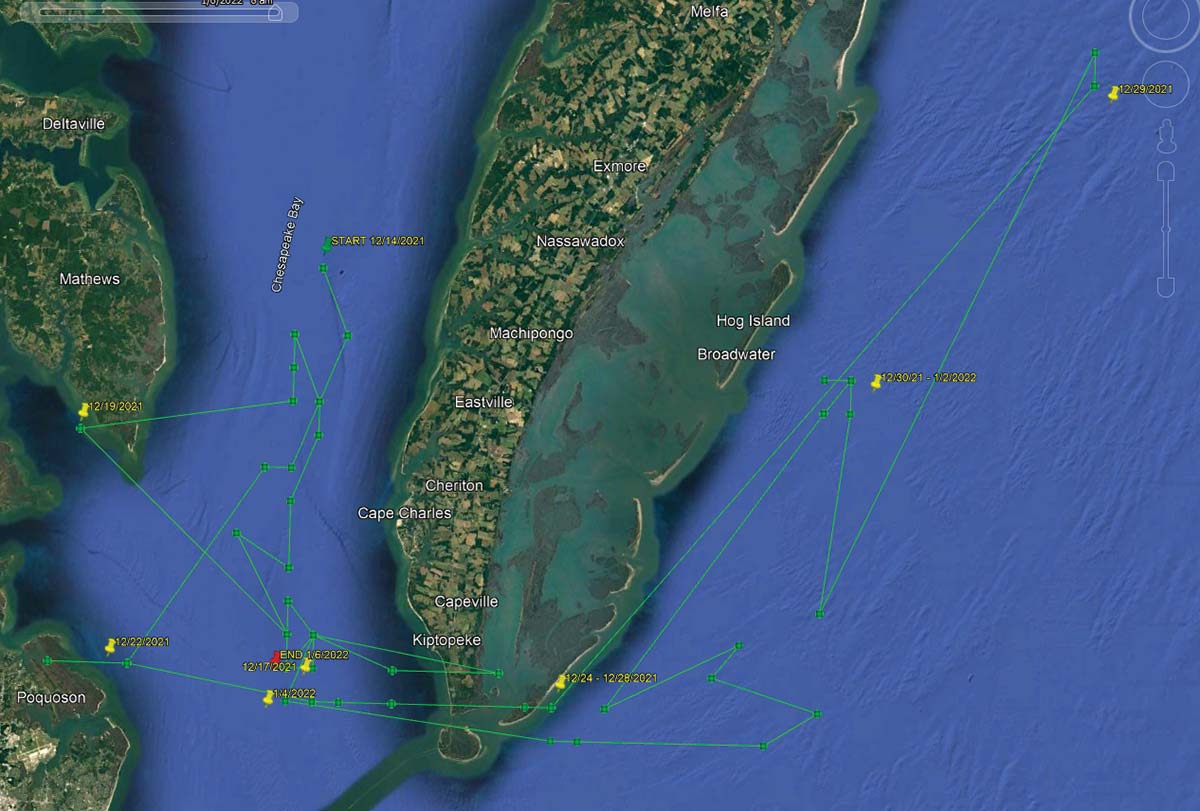
“Why when we tag small striped bass that historical data tells us are supposed to stay near their spawning river, do they get recaptured hundreds of miles away,” Many asks, followed by “Why do we put a MiniPAT device in a striped bass, and rather than behaving like the ‘inshore’ fish we’ve always understood them to be, why do we find that a handful of these big stripers have traveled so far offshore?”
After 40 years of dedicated striper fishing from New England to the Outer Banks, Chuck Many’s takeaway is rather simple and direct. “The one thing that I do know is that we don’t know! And that is why I tag so many striped bass.”
“My goal working with Gray Fishtag Research and the Northeast Striped Bass Study is to help convince people that we don’t know what we think we know, and that maybe it’s time that we open our minds to let more data bring us more knowledge,” said Many, adding “Perhaps then we can better protect this awesome sportfish for the future.”
I’m no scientist; but if we as anglers are willing to help provide more data, doesn’t that help lead to better science?


